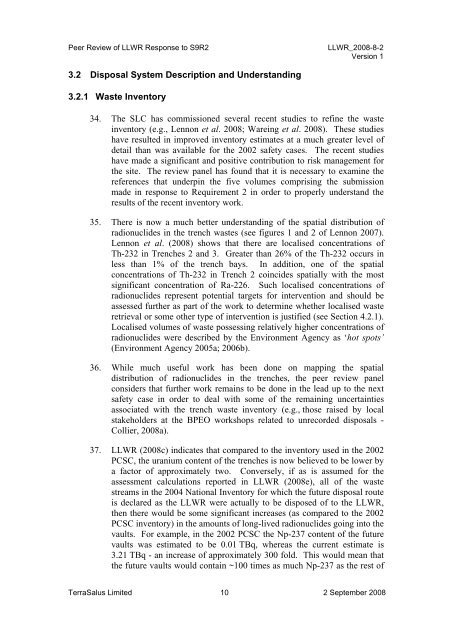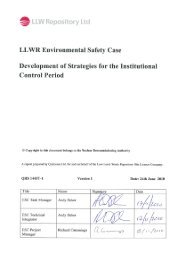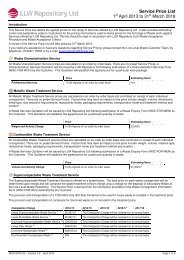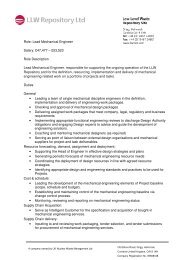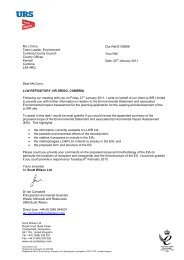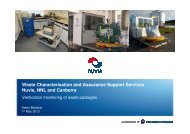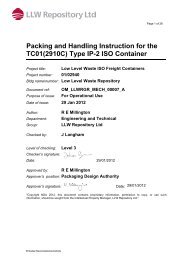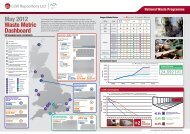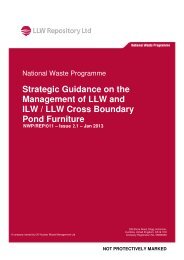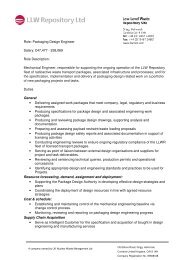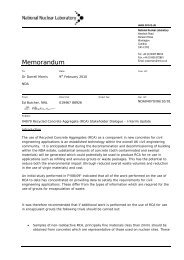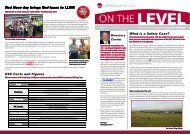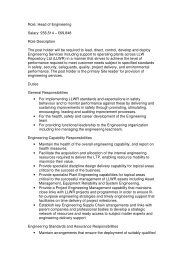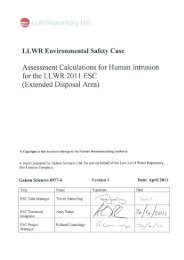Independent Peer Review of - Low Level Waste Repository Ltd
Independent Peer Review of - Low Level Waste Repository Ltd
Independent Peer Review of - Low Level Waste Repository Ltd
Create successful ePaper yourself
Turn your PDF publications into a flip-book with our unique Google optimized e-Paper software.
<strong>Peer</strong> <strong>Review</strong> <strong>of</strong> LLWR Response to S9R2LLWR_2008-8-2Version 13.2 Disposal System Description and Understanding3.2.1 <strong>Waste</strong> Inventory34. The SLC has commissioned several recent studies to refine the wasteinventory (e.g., Lennon et al. 2008; Wareing et al. 2008). These studieshave resulted in improved inventory estimates at a much greater level <strong>of</strong>detail than was available for the 2002 safety cases. The recent studieshave made a significant and positive contribution to risk management forthe site. The review panel has found that it is necessary to examine thereferences that underpin the five volumes comprising the submissionmade in response to Requirement 2 in order to properly understand theresults <strong>of</strong> the recent inventory work.35. There is now a much better understanding <strong>of</strong> the spatial distribution <strong>of</strong>radionuclides in the trench wastes (see figures 1 and 2 <strong>of</strong> Lennon 2007).Lennon et al. (2008) shows that there are localised concentrations <strong>of</strong>Th-232 in Trenches 2 and 3. Greater than 26% <strong>of</strong> the Th-232 occurs inless than 1% <strong>of</strong> the trench bays. In addition, one <strong>of</strong> the spatialconcentrations <strong>of</strong> Th-232 in Trench 2 coincides spatially with the mostsignificant concentration <strong>of</strong> Ra-226. Such localised concentrations <strong>of</strong>radionuclides represent potential targets for intervention and should beassessed further as part <strong>of</strong> the work to determine whether localised wasteretrieval or some other type <strong>of</strong> intervention is justified (see Section 4.2.1).Localised volumes <strong>of</strong> waste possessing relatively higher concentrations <strong>of</strong>radionuclides were described by the Environment Agency as ‘hot spots’(Environment Agency 2005a; 2006b).36. While much useful work has been done on mapping the spatialdistribution <strong>of</strong> radionuclides in the trenches, the peer review panelconsiders that further work remains to be done in the lead up to the nextsafety case in order to deal with some <strong>of</strong> the remaining uncertaintiesassociated with the trench waste inventory (e.g., those raised by localstakeholders at the BPEO workshops related to unrecorded disposals -Collier, 2008a).37. LLWR (2008c) indicates that compared to the inventory used in the 2002PCSC, the uranium content <strong>of</strong> the trenches is now believed to be lower bya factor <strong>of</strong> approximately two. Conversely, if as is assumed for theassessment calculations reported in LLWR (2008e), all <strong>of</strong> the wastestreams in the 2004 National Inventory for which the future disposal routeis declared as the LLWR were actually to be disposed <strong>of</strong> to the LLWR,then there would be some significant increases (as compared to the 2002PCSC inventory) in the amounts <strong>of</strong> long-lived radionuclides going into thevaults. For example, in the 2002 PCSC the Np-237 content <strong>of</strong> the futurevaults was estimated to be 0.01 TBq, whereas the current estimate is3.21 TBq - an increase <strong>of</strong> approximately 300 fold. This would mean thatthe future vaults would contain ~100 times as much Np-237 as the rest <strong>of</strong>TerraSalus Limited 10 2 September 2008


